Abstract
The effects of a preparation of purified brain ganglioside and of neuraminic acid have been studied on various pharmacological test preparations. In concentrations of 10 μg/ml. or more, ganglioside stimulates the isolated guinea-pig ileum; graded responses are usually obtained. Various substances, known to antagonize the actions of other stimulant substances, fail to affect the response to ganglioside. Ganglioside and neuraminic acid neither stimulate the superior cervical ganglion of the cat nor do they affect ganglionic transmission. Ganglioside and neuraminic acid did not change the response of the frog rectus abdominis muscle to acetylcholine, nor did they affect the blood pressure of the cat. Ganglioside (2 μg/ml. or more) stimulates the isolated heart of Venus mercenaria, but the response, which develops slowly, decreases with repeated administration of ganglioside. The response is not blocked by 2-bromo-lysergic acid diethylamide and there is no indication that it is due to the liberation of endogenous 5-hydroxytryptamine or related indole compounds. For both the heart of Venus mercenaria and guinea-pig ileum, the activity demonstrated by brain ganglioside is specifically a property of the whole molecule, since neither neuraminic acid itself nor a preparation of brain ganglioside from which only two-thirds of its neuraminic acid had been removed are active.
Full text
PDF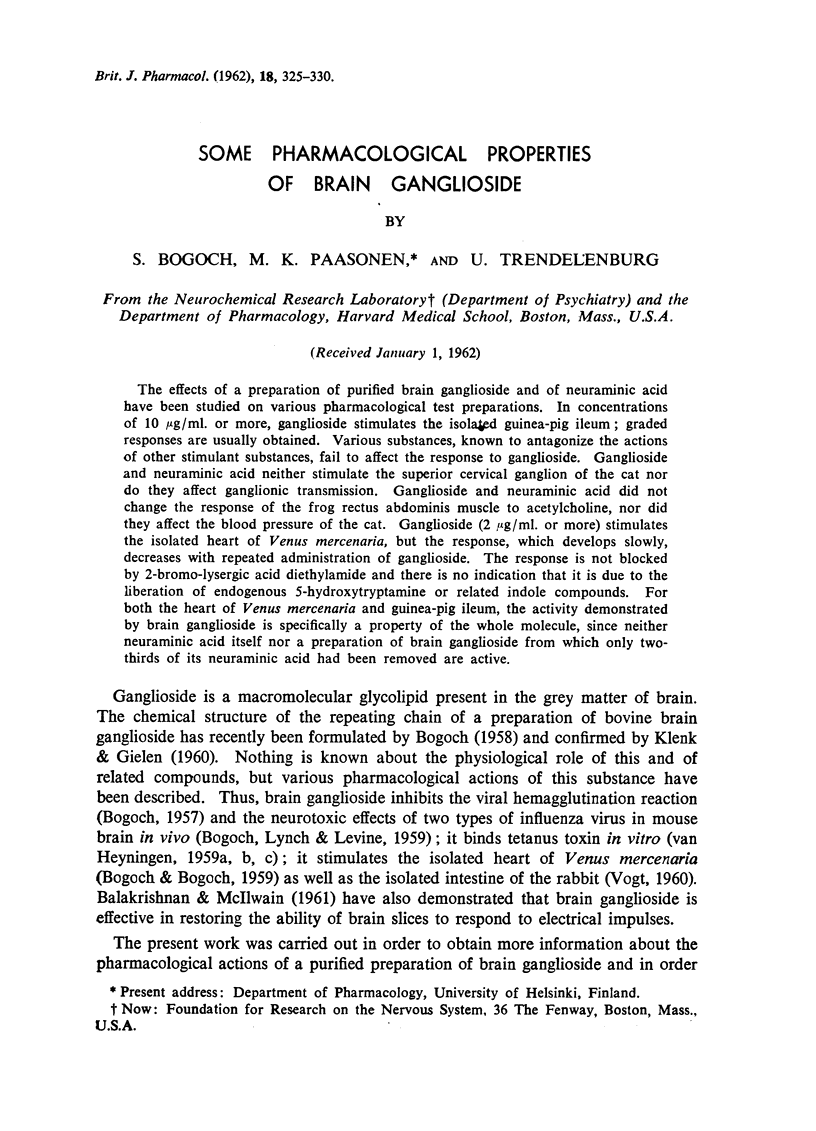
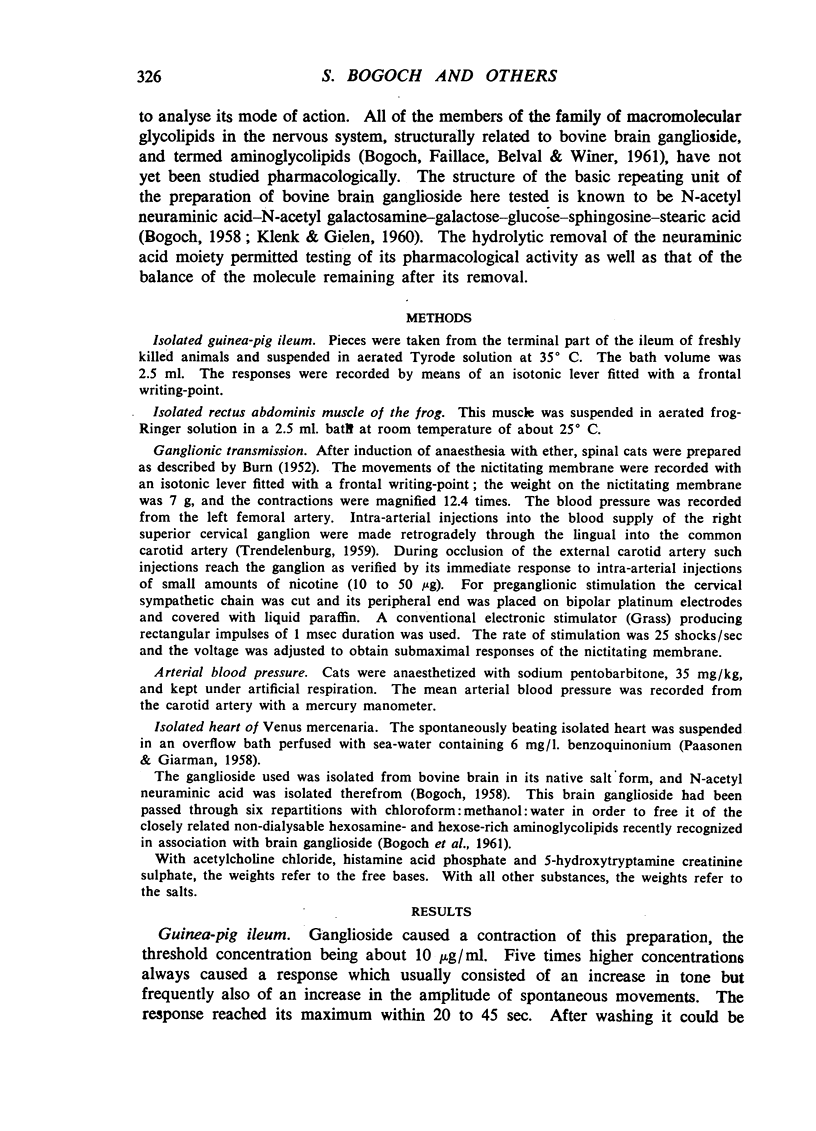
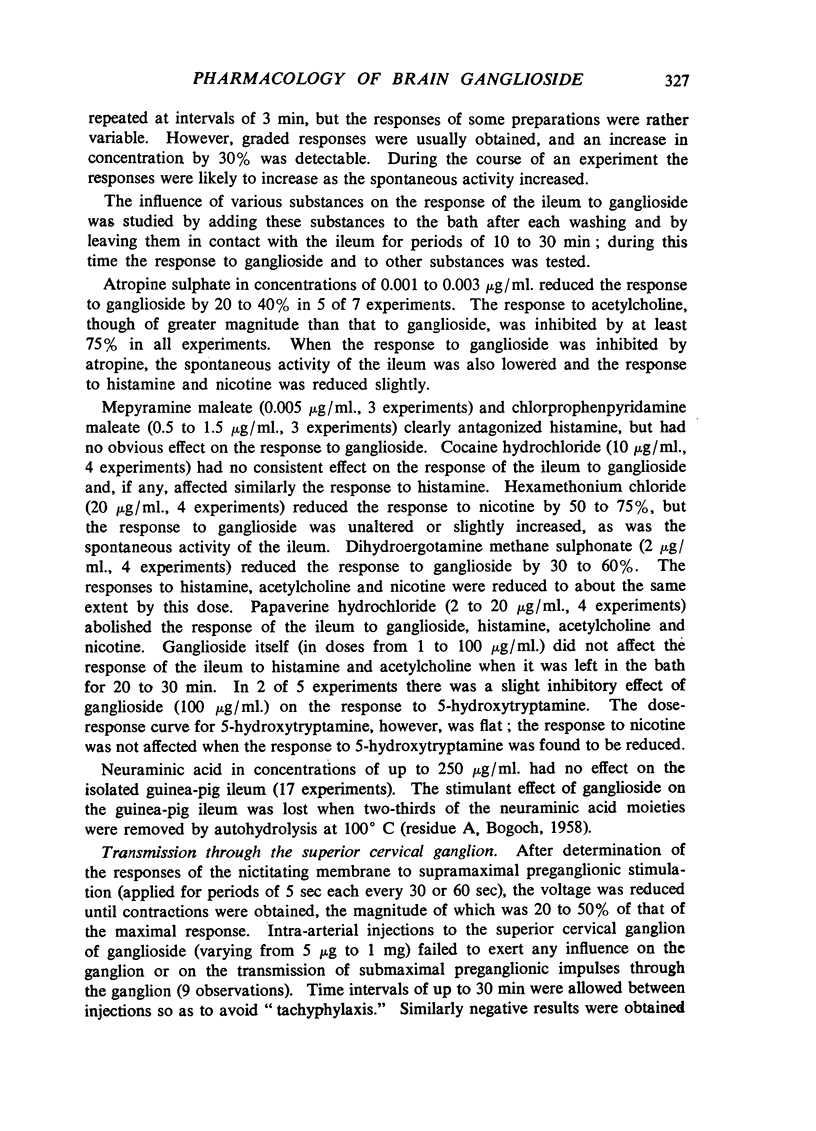
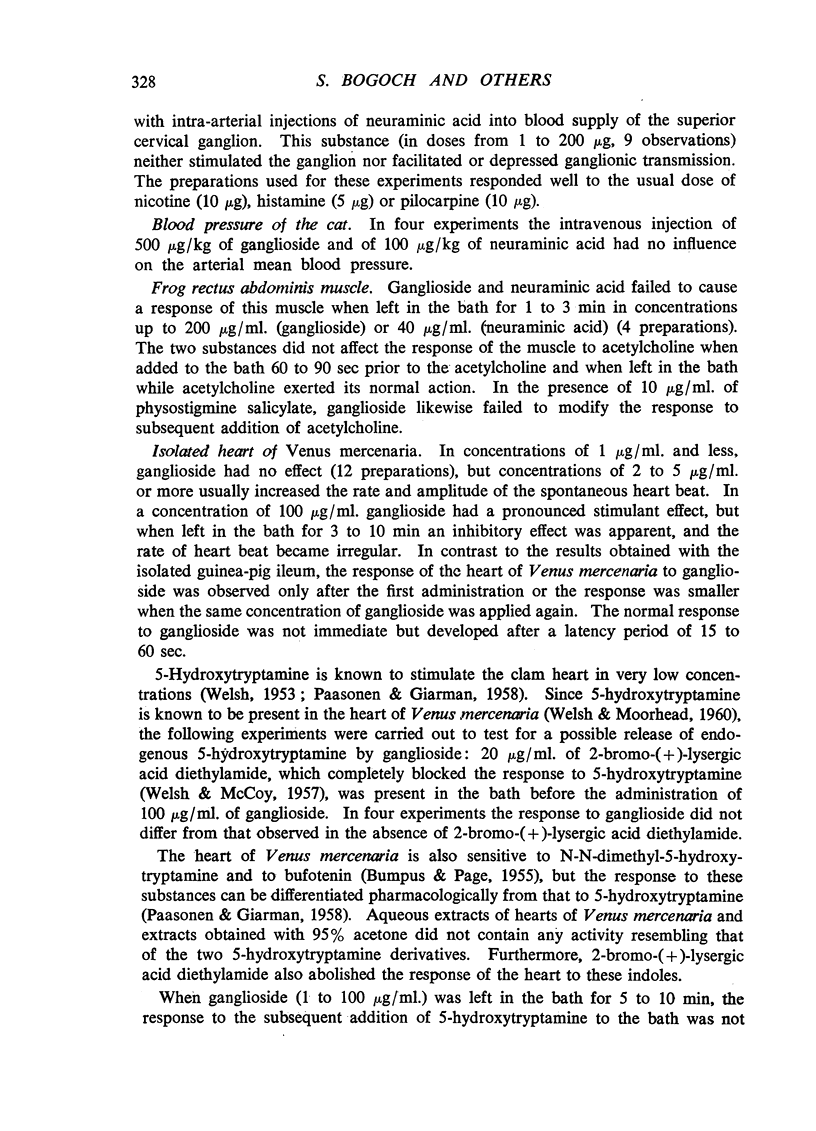
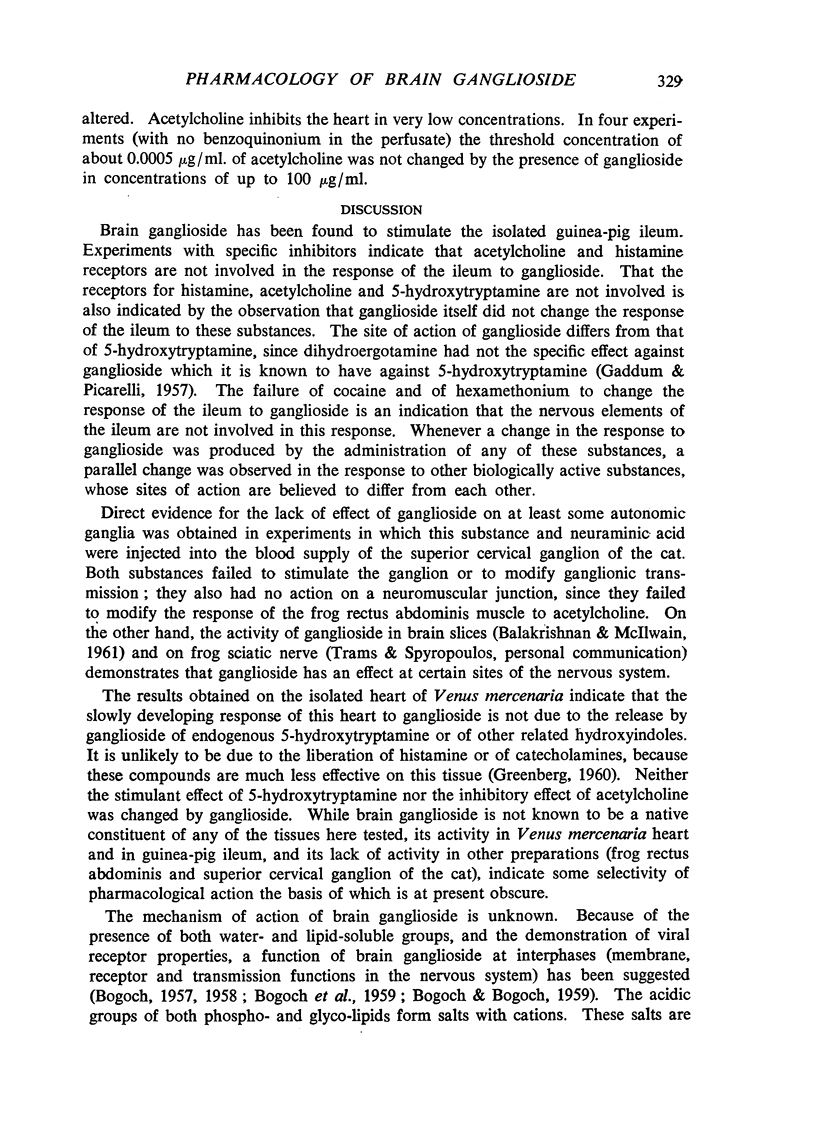

Selected References
These references are in PubMed. This may not be the complete list of references from this article.
- BALAKRISHNAN S., McIL WAIN H. Gangliosides and related substances of isolated cerebral tissues examined in relation to tissue excitability. Biochem J. 1961 Oct;81:72–78. doi: 10.1042/bj0810072. [DOI] [PMC free article] [PubMed] [Google Scholar]
- BOGOCH S., BOGOCH E. S. Effect of brain ganglioside on the heart of the clam. Nature. 1959 Jan 3;183(4653):53–54. doi: 10.1038/183053a0. [DOI] [PubMed] [Google Scholar]
- BOGOCH S. Inhibition of viral hemagglutination by brain ganglioside. Virology. 1957 Dec;4(3):458–466. doi: 10.1016/0042-6822(57)90079-x. [DOI] [PubMed] [Google Scholar]
- BOGOCH S., LYNCH P., LEVINE A. S. Influence of brain ganglioside upon the neurotoxic effect of influenza virus in mouse brain. Virology. 1959 Feb;7(2):161–169. doi: 10.1016/0042-6822(59)90184-9. [DOI] [PubMed] [Google Scholar]
- BOGOCH S. Studies on the structure of brain ganglioside. Biochem J. 1958 Feb;68(2):319–326. doi: 10.1042/bj0680319. [DOI] [PMC free article] [PubMed] [Google Scholar]
- BUMPUS F. M., PAGE I. H. Serotonin and its methylated derivatives in human urine. J Biol Chem. 1955 Jan;212(1):111–116. [PubMed] [Google Scholar]
- GADDUM J. H., PICARELLI Z. P. Two kinds of tryptamine receptor. Br J Pharmacol Chemother. 1957 Sep;12(3):323–328. doi: 10.1111/j.1476-5381.1957.tb00142.x. [DOI] [PMC free article] [PubMed] [Google Scholar]
- GREENBERG M. J. The responses of the Venus heart to catechol amines and high concentration of 5-hydroxytryptamine. Br J Pharmacol Chemother. 1960 Sep;15:365–374. doi: 10.1111/j.1476-5381.1960.tb01259.x. [DOI] [PMC free article] [PubMed] [Google Scholar]
- KLENK E., GIELEN W. [On studies on the brain gangliosides]. Hoppe Seylers Z Physiol Chem. 1960;319:283–286. doi: 10.1515/bchm2.1960.319.1.283. [DOI] [PubMed] [Google Scholar]
- MCCOY A. C., WELSH J. H. Actions of dlysergic acid diethylamide and its 2-bromo derivative on heart of Venus mercenaria. Science. 1957 Feb 22;125(3243):348–348. doi: 10.1126/science.125.3243.348. [DOI] [PubMed] [Google Scholar]
- PAASONEN M. K., GIARMAN N. J. Brain levels of 5-hydroxytryptamine after various agents. Arch Int Pharmacodyn Ther. 1958 Mar 1;114(2):189–200. [PubMed] [Google Scholar]
- TRENDELENBURG U. Non-nicotinic ganglion-stimulating substances. Fed Proc. 1959 Dec;18:1001–1005. [PubMed] [Google Scholar]
- VAN HEYNINGEN W. E. Chemical assay of the tetanus toxin receptor in nervous tissue. J Gen Microbiol. 1959 Apr;20(2):301–309. doi: 10.1099/00221287-20-2-301. [DOI] [PubMed] [Google Scholar]
- VAN HEYNINGEN W. E. Tentative identification of the tetanus toxin recptor in nervous tissue. J Gen Microbiol. 1959 Apr;20(2):310–320. doi: 10.1099/00221287-20-2-310. [DOI] [PubMed] [Google Scholar]
- VAN HEYNINGEN W. E. The fixation of tetanus toxin by nervous tissue. J Gen Microbiol. 1959 Apr;20(2):291–300. doi: 10.1099/00221287-20-2-291. [DOI] [PubMed] [Google Scholar]
- VOGT W. Chemische und pharmakologische Eigenschaften saurer Phospholipide (Darmstoff). Arzneimittelforschung. 1958 May;8(5):253–263. [PubMed] [Google Scholar]
- VOGT W. [Intestine-stimulating activity of various phosphatides and glycolipids]. Naunyn Schmiedebergs Arch Exp Pathol Pharmakol. 1960;240:134–139. [PubMed] [Google Scholar]
- WELSH J. H. Excitation of the heart of Venus mercenaria. Naunyn Schmiedebergs Arch Exp Pathol Pharmakol. 1953;219(1-2):23–29. doi: 10.1007/BF00246246. [DOI] [PubMed] [Google Scholar]
- WELSH J. H., MOORHEAD M. The quantitative distribution of 5-hydroxytryptamine in the invertebrates, especially in their nervous systems. J Neurochem. 1960 Sep;6:146–169. doi: 10.1111/j.1471-4159.1960.tb13460.x. [DOI] [PubMed] [Google Scholar]


